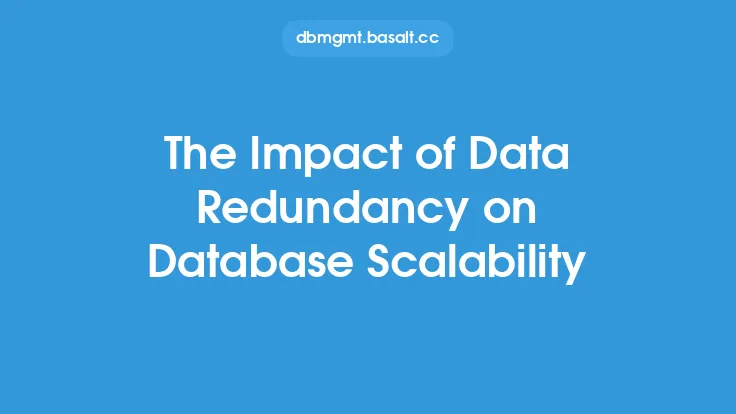Database scalability is a critical aspect of database performance optimization, as it enables databases to handle increasing workloads and user demands without compromising performance. One key factor that affects database scalability is resource utilization. Resource utilization refers to the efficient use of database resources, such as CPU, memory, storage, and network bandwidth, to process database queries and transactions. In this article, we will explore the impact of resource utilization on database scalability and discuss strategies for optimizing resource utilization to improve database scalability.
Introduction to Database Scalability
Database scalability is the ability of a database to handle increasing workloads and user demands without compromising performance. A scalable database can handle increased traffic, data volume, and user activity without experiencing significant performance degradation. Database scalability is critical in today's fast-paced digital landscape, where databases are expected to handle large volumes of data and support high-traffic applications. There are several factors that affect database scalability, including hardware resources, database design, query optimization, and resource utilization.
The Role of Resource Utilization in Database Scalability
Resource utilization plays a crucial role in database scalability. When database resources are utilized efficiently, databases can handle increased workloads and user demands without experiencing performance degradation. On the other hand, inefficient resource utilization can lead to performance bottlenecks, slow query execution, and decreased database scalability. There are several database resources that are critical to database scalability, including CPU, memory, storage, and network bandwidth. CPU resources are responsible for executing database queries and transactions, while memory resources are used to cache data and improve query performance. Storage resources are used to store database data, and network bandwidth is used to transmit data between database nodes.
Impact of Inefficient Resource Utilization on Database Scalability
Inefficient resource utilization can have a significant impact on database scalability. When database resources are not utilized efficiently, databases can experience performance bottlenecks, slow query execution, and decreased scalability. For example, if CPU resources are underutilized, databases may not be able to handle increased workloads, leading to slow query execution and decreased performance. On the other hand, if CPU resources are overutilized, databases may experience performance bottlenecks, leading to slow query execution and decreased scalability. Similarly, inefficient memory utilization can lead to decreased query performance, while inefficient storage utilization can lead to decreased data throughput.
Strategies for Optimizing Resource Utilization
There are several strategies for optimizing resource utilization to improve database scalability. One strategy is to monitor database resource utilization and identify performance bottlenecks. This can be done using database monitoring tools, such as SQL Server Management Studio or Oracle Enterprise Manager. Once performance bottlenecks are identified, database administrators can take steps to optimize resource utilization, such as indexing tables, optimizing queries, and adjusting database configuration parameters. Another strategy is to implement resource pooling, which involves pooling database resources, such as CPU and memory, to improve resource utilization. Resource pooling can be implemented using database features, such as SQL Server's resource governor or Oracle's resource manager.
Best Practices for Resource Utilization
There are several best practices for resource utilization that can help improve database scalability. One best practice is to monitor database resource utilization regularly and take steps to optimize resource utilization as needed. Another best practice is to implement resource pooling and resource governance to improve resource utilization. Additionally, database administrators should optimize database configuration parameters, such as buffer cache size and sort area size, to improve resource utilization. Finally, database administrators should consider implementing database features, such as data compression and data encryption, to reduce resource utilization and improve database scalability.
Technical Considerations for Resource Utilization
There are several technical considerations for resource utilization that database administrators should be aware of. One technical consideration is the impact of database design on resource utilization. For example, a poorly designed database can lead to inefficient resource utilization, while a well-designed database can lead to efficient resource utilization. Another technical consideration is the impact of query optimization on resource utilization. For example, optimized queries can reduce resource utilization, while unoptimized queries can increase resource utilization. Additionally, database administrators should consider the impact of database configuration parameters on resource utilization, such as the impact of buffer cache size on query performance.
Conclusion
In conclusion, resource utilization has a significant impact on database scalability. Inefficient resource utilization can lead to performance bottlenecks, slow query execution, and decreased database scalability, while efficient resource utilization can improve database scalability and performance. By monitoring database resource utilization, implementing resource pooling and resource governance, and optimizing database configuration parameters, database administrators can improve resource utilization and database scalability. Additionally, database administrators should consider technical considerations, such as database design and query optimization, to ensure efficient resource utilization and improved database scalability. By following these strategies and best practices, database administrators can ensure that their databases are scalable, performant, and able to handle increasing workloads and user demands.





